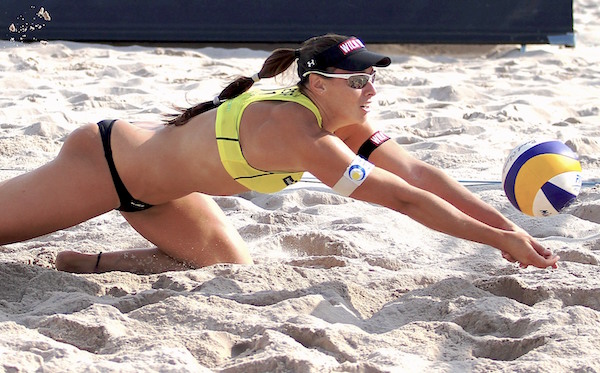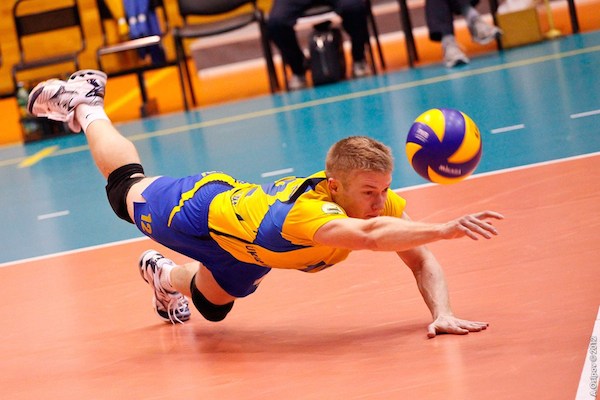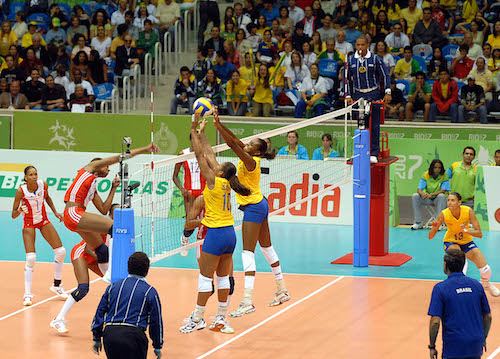All About Beach Volleyball
I don’t know about you, but when I think of summer, I think of sun, water, and sand. While lots of Summer Olympic events take place in water or in the sun, only one that I can think of directly involves sand: beach volleyball.
How Does Beach Volleyball Work?
A beach volleyball court is 16 by 8 meters (about 53 by 26 feet) divided into two equal halves and divided by a net strung seven and a half or eight feet above the ground. Beach volleyball is always played in teams of two. Beach volleyball players pair up, if not for life, at least for the duration of an Olympics, and usually much longer. Communication is key, because the two players have a lot of space to cover and movement in the sand is slower and harder than on grass or wood. Even more important than the verbal communication that goes on between players during the game is the unspoken knowledge of each other that grows over years in a pair. You may also notice players communicating before points with hand signs, usually held right behind their butts so that the other team can’t see what is going on.
Beach volleyball matches consist of up to three sets, of which the first team to win two wins the match. The first two sets are played to 21 points, the third, if necessary, to 15. Games must be won by two points, so if the teams are very close, you may see scores higher than 21. Points can be scored on any rally, not only on a team’s serve like they used to be. A point is scored by forcing the ball to hit the sand in the opponent’s half of the court or by allowing the ball to hit the sand outside of the court if an opponent was the last player to touch the ball.
Why do People Like Watching Beach Volleyball?
Remember I mentioned that players hold their fingers behind their butts to communicate with each other before points? Well, television producers are overjoyed to use this as an excuse to have their cameras linger on beach volleyball olympic butts. Sex appeal is not the only draw to the sport though — far from it. As anyone who has ever tried to run or jump in sand knows, it takes a gargantuan amount of power and stamina to do it effectively and for any extended period. Beach volleyball is certainly a strength and an endurance sport but it also has a lot of technique and tactics. I also think that two person teams are one of the most fun events to watch. As a spectator, you can develop a fandom for a pair that doesn’t verge on creepy the way that rooting for individuals sometimes feels, but is more intimate that rooting for a team of 12 or 20.
Check out some highlights from the 2012 Olympics:
What are the different events?
There are two medal events in the Olympics for beach volleyball – a men’s event and a women’s.
How Dangerous is Beach Volleyball?
One of the joys of playing beach volleyball, even at a very very low level, is that when you dive for a ball, you land on soft sand, not a scrapey wood floor. Beach volleyball is a very safe sport to play. You’ll rarely see a team have to withdraw because of injury, but you do often see players taping up their fingers, wrists, shoulders, or leg muscles, all of which take a beating from this sport.
What’s the State of Gender Equality in Beach Volleyball?
So… here’s the thing. The sport itself is not so bad. There are two gold medals, one for women, one for men, each of which have an even number of teams and athletes competing for it. The net is slightly lower for women than for men, but I’m not horribly opposed to this type of difference that recognizes the difference between the average height of men and women. No, the bigger problem in beach volleyball, which makes this a bad sport in terms of gender equality, is the uniforms! Men wear reasonably baggy shorts and loose tank top shirts. Women wear skimpy two piece swim suits. I don’t think either uniform is better or worse for playing beach volleyball, so why have a difference at all? I’d vote for putting both genders in tight swim suits, but I’d also accept putting both in looser athletic wear.
Links!
Bookmark the full Olympics schedule from NBC. Beach Volleyball is from Saturday, August 6 to Thursday, August 18.
Read more about beach volleyball on the official Rio Olympics site.




